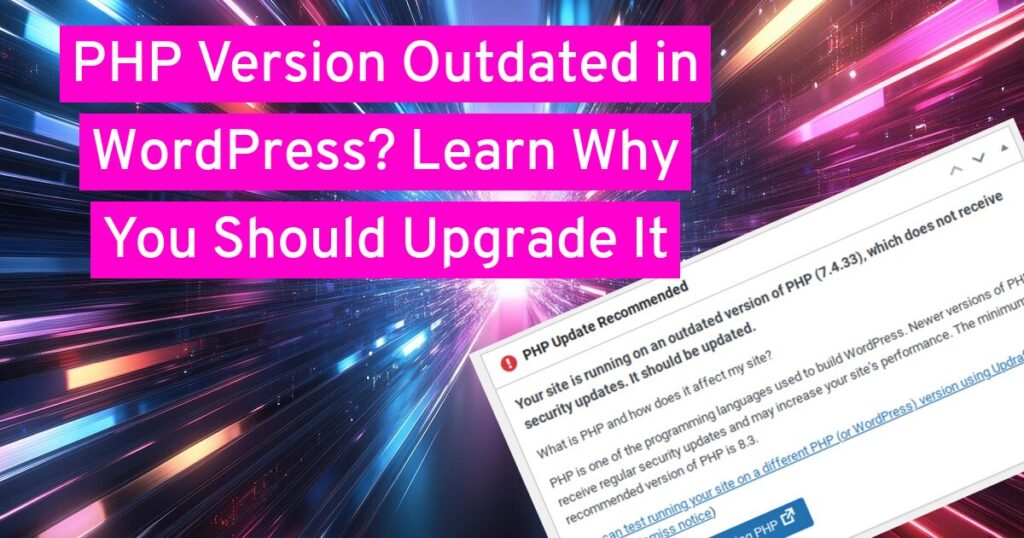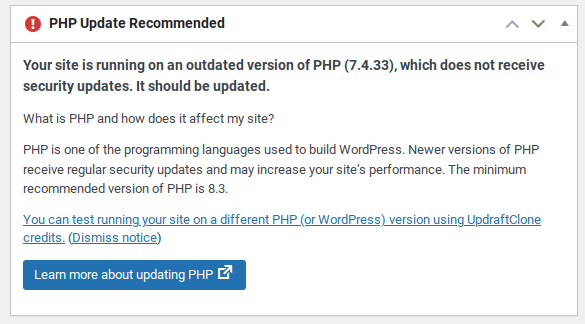
It’s important to keep your WordPress site’s PHP version updated because it directly impacts your site’s security, performance, and compatibility. Ignoring PHP updates leaves your site vulnerable to security threats, slows it down, and can lead to compatibility issues with the latest WordPress core, themes, and plugins. In this article, you’ll learn about the role of PHP in WordPress, why you should keep the PHP version up-to-date, and how to update your PHP.
What WordPress Uses PHP For
At its core, WordPress is a PHP application. PHP is short for Hypertext Preprocessor. When someone visits your website, the request goes to your web server, which then processes the PHP files that make up WordPress. If PHP were a car part, PHP acts as the “engine” of your site, performing a wide range of tasks to generate the web page that a user sees.
The Role of PHP in a WordPress Website
- Content Generation: PHP is what fetches your post content, page titles, and other data from the MySQL database and assembles it into an HTML page that the user’s browser can display. Without PHP, your WordPress site would just be static files with no dynamic content.
- Theme and Plugin Functionality: Every WordPress theme and plugin is built using PHP. These files contain the code that dictates how your site looks and how it functions. For example, the functions.php file in a theme is a PHP file that allows you to add custom features or modify existing behaviors.Plugins use PHP to add interactive elements, forms, SEO tools, and more.
- Database Interaction: All of your site’s content, from blog posts to user information and plugin settings, is stored in a database. PHP is the language that allows WordPress to communicate with this database, both retrieving information to display on the front end and saving new data when you make changes.
- User Management: PHP handles core functionalities like user registration, login, and session management, ensuring that users are authenticated and their access is properly managed.
In short, PHP is what makes a WordPress site dynamic. It’s the server-side scripting language that runs all the code behind the scenes to create the interactive, data-driven website that your visitors see.
Reasons to Update Your PHP Version
Updating your WordPress site to the latest supported PHP version is not just a recommendation – it’s a necessity. It provides three primary benefits that are non-negotiable for a healthy, successful website: security, performance, and compatibility.
- Improved Security
- Enhanced Performance
- Better Compatibility and New Features
Improved Security
This is arguably the most important reason to keep your PHP version current. Every PHP version has a life-cycle, which includes a period of active support and then a period of security support. When a version reaches its End of Life (EOL), it no longer receives official security updates or bug fixes from the PHP community.
- Protection from Known Vulnerabilities: As a widely-used language, PHP is a common target for attackers. Each new version is released with patches for vulnerabilities discovered in previous versions. If your site is running on an outdated PHP version, it’s susceptible to known security flaws that hackers can easily exploit.
- Reduced Attack Surface: Newer versions of PHP often remove old, insecure functions, which reduces the potential points of entry for attackers. They also introduce stricter data handling and more robust security features.
- Preventing Malware and Data Theft: An exploited vulnerability in an old PHP version can lead to a complete site takeover, the injection of malicious code, or the theft of sensitive user data.Staying updated is your first line of defense.
The risks of an outdated PHP version are not to be underestimated. They are a significant, tangible threat to your site and your users.
Enhanced Performance
Every new version of PHP is built with performance improvements and optimizations. These enhancements directly translate to a faster website, which is a major factor for both user experience and Search Engine Optimization (SEO).
- Faster Execution Times: Benchmarks consistently show that newer PHP versions are significantly faster than their predecessors. For example, a site running on PHP 8.3 can execute code much more efficiently than one on PHP 7.4. This means your server can process requests more quickly, leading to faster page load times.
- Lower Memory and CPU Usage: With each update, PHP becomes more efficient at managing resources. This means your server can handle more traffic with the same amount of resources, or it can handle the same amount of traffic with less strain. This can save you money on hosting and prevent your site from crashing during traffic spikes.
- Improved Time to First Byte (TTFB): A key performance metric, TTFB, measures the time it takes for a browser to receive the first byte of data from the server.Newer PHP versions can drastically reduce this time, making your site feel more responsive.
- Just-In-Time (JIT) Compilation: Introduced in PHP 8.0, JIT compilation is a major performance boost. It compiles code into native machine code at runtime, which can significantly speed up complex, long-running processes.
A faster website leads to a better user experience, higher visitor engagement, and improved search engine rankings.
Better Compatibility and New Features
WordPress and the ecosystem of plugins and themes are constantly evolving. Developers work to ensure their products are compatible with the latest web technologies, and that often means leveraging the new features and functionalities of modern PHP versions.
- Compatibility with WordPress Core: The WordPress core team actively updates the platform to be compatible with and recommend the latest PHP versions. Running an outdated version of PHP can lead to compatibility warnings or, in some cases, outright errors when you try to update WordPress itself.
- Plugin and Theme Support: Developers of high-quality plugins and themes will also update their code to be compatible with the latest PHP. If you’re running an old PHP version, you may be unable to update your plugins or themes, missing out on new features, bug fixes, and critical security patches.
- Access to Modern Development Tools: Newer PHP versions introduce new syntax, functions, and features that make it easier for developers to write cleaner, more efficient, and more secure code. By staying updated, you ensure that your site is built on a foundation that supports these modern coding practices.
- Avoid Deprecated Functions: As PHP evolves, older functions are often deprecated (marked for removal). If your site relies on a plugin or theme that uses these deprecated functions, an update to a new PHP version could break your site. However, staying current ensures that developers have to update their code to work with the latest PHP, which is a good thing for the long-term health of your site.
While it’s true that updating PHP can sometimes lead to a compatibility issue with an outdated plugin or theme, this is a signal that those components are no longer being maintained and should be replaced. It’s a proactive measure to ensure the longevity and stability of your site.
How to Update Your WordPress Site’s PHP Version

Updating your PHP version is a straightforward process, but it should be done carefully to avoid breaking your site.
- Check Your Current PHP Version
- Check for Plugin and Theme Compatibility
- Back Up Your Site
- Update the PHP Version
- Monitor Your Site
Check Your Current PHP Version

First, you need to know what version you’re currently using. Most modern hosting providers have a control panel (like cPanel or Plesk) where you can easily find and change your PHP version. WordPress also has a built-in Site Health feature that will tell you your current PHP version. You can find this under Tools > Site Health > Info.
Check for Plugin and Theme Compatibility
This is the most critical step. Before you update, make sure all your plugins and themes are compatible with the new PHP version. You can do this by:
- Updating Everything First: Make sure all your themes, plugins, and WordPress core are updated to their latest versions. Developers will often fix compatibility issues in these updates.
- Using a Staging Environment: This is the safest way to test. A staging environment is a private copy of your website that you can use to make changes without affecting your live site. Most hosts offer a one-click staging environment. On your staging site, update the PHP version and test all your site’s functionality.
- Using a Compatibility Checker Plugin: Plugins like PHP Compatibility Checker can scan your site’s code and report any functions that are incompatible with a newer PHP version.
Back Up Your Site
Before making any major changes, always create a full backup of your website’s files and database. This is your safety net. If something goes wrong, you can easily restore your site to its previous state.
Update the PHP Version
Once you’ve done your due diligence, you can change the PHP version in your hosting control panel. The process can vary slightly between hosts, but it’s usually a simple drop-down menu where you select the desired version.
Monitor Your Site
After updating, check your site immediately for any errors. Look at the front end (the part your visitors see) and the back end (the admin dashboard). If you see any errors or a “white screen of death,” you can quickly revert to the old PHP version while you troubleshoot the issue.
Also, make sure to check your error_log. This type of text file can usually be found on the same file directory level as your wp-config.php file. While some errors might not be seen on the frontend of the website, you don’t want to have errors piling up behind the scenes. A huge error log file can start slowing down your website.
In some cases, if a plugin or theme isn’t compatible with the latest PHP version, you can use the error as a guide on what needs to be fixed.
As a note, if you’re not comfortable doing all of this or not code savvy enough to fix any PHP errors while getting your WordPress website compatible with PHP 8.3, you can hire me and I’ll do an audit, then work to get your website’s PHP upgraded to the latest recommended version.
In Summary
Keeping your WordPress site’s PHP version updated is not an optional task; it’s a super important part of responsible website ownership. By staying current, you’re not just keeping up with technology – you’re actively protecting your site from security threats, ensuring it runs as fast as possible, and guaranteeing its long-term compatibility with the ever-evolving WordPress ecosystem.
This is a very informative blog! Just like using the right Organic Fertilizer keeps crops healthy and productive, keeping your WordPress PHP version updated ensures your website runs smoothly and efficiently. Brands like Radhakrit remind us that quality and care matter in every field, whether in agriculture or technology.
That’s a very good example in relation to what your site offers.